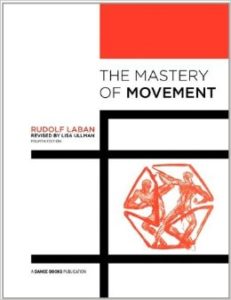 Laban wrote Mastery of Movement on the Stage (1st edition) “as an incentive to personal mobility.” And indeed, the first two chapters provide a number of explorations organized around movement themes focused on body and/or effort. Laban hopes to encourage a kind of “mobile reading,” as he explains in the Preface.
Laban wrote Mastery of Movement on the Stage (1st edition) “as an incentive to personal mobility.” And indeed, the first two chapters provide a number of explorations organized around movement themes focused on body and/or effort. Laban hopes to encourage a kind of “mobile reading,” as he explains in the Preface.
However, he also notes that there is something in the book for those who want to remain in a comfy chair. That is, such readers can learn more about “thinking in terms of movement.” For Laban, mobile thinking is not merely “cavorting in the world of ideas” any more than stage movement is “restricted to ballet.” And herein Laban reveals his broader theme: movement “forms the common denominator to both art and industry.”
In the Preface, Laban also makes it quite clear that movement is not merely a physical practice that can be mastered through mechanical exercises. Movement involves the “inner life of man.” For genuine mastery, the motivation to move must be integrated with the acquisition of external skill.
Laban also establishes his views on theatre, noting that the stage is “the mirror of man’s physical, mental, and spiritual existence.” And in the Introduction, he goes on to assert that movement is the heart of theatre, for there is no acting, speaking, singing, or dancing without movement.
In many ways, Mastery of Movement is a quintessential representation of Laban’s vision, which illuminates details of bodily activity and yet broadly positions the whole experience of movement in relation to human existence in the world of both tangible and intangible values.
Find out more in the upcoming correspondence course, Mastering Rudolf Laban’s Mastery of Movement.

 I didn’t start out to write an introductory Laban Movement Analysis text. It began as a compilation of teaching materials I’ve developed over the last three decades, teaching in Certificate Programs in New York, Chicago, Seattle, Los Angeles, Salt Lake City, Berlin, The Netherlands, and England.
I didn’t start out to write an introductory Laban Movement Analysis text. It began as a compilation of teaching materials I’ve developed over the last three decades, teaching in Certificate Programs in New York, Chicago, Seattle, Los Angeles, Salt Lake City, Berlin, The Netherlands, and England.